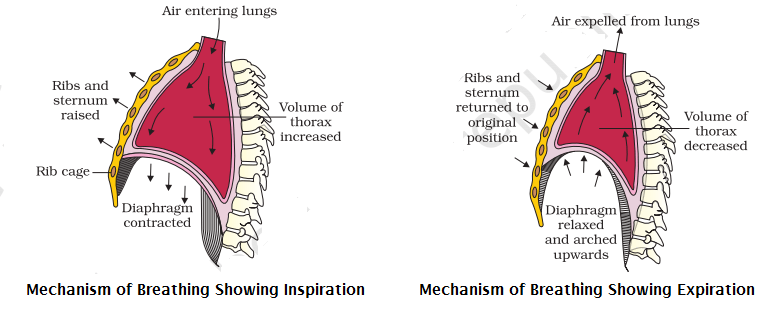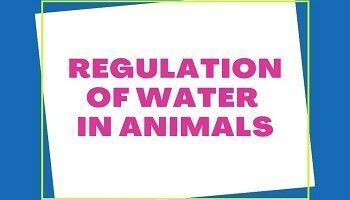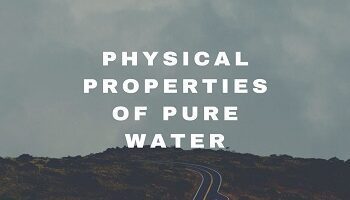Table of Contents
Mechanism of Breathing:
Breathing is defined as the process in which the respiratory gases are regularly exchanged between the atmosphere and the respiratory organs or the lungs.
The rhythmic act of breathing involves inward and outward flow of air that is brought about by changing the size of the thoracic cavity and ultimately, resulting in creating a pressure gradient between lungs and the atmosphere. This is done by two ways-
- The downward and upward movement of the diaphragm, which lengthens and shortens the chest cavity.
- The elevation and depression of the ribs which increase or decrease the diameter of the chest cavity.
This process occurs in two steps- inspiration and expiration.
Inspiration (Inhalation):
It is inhalation or drawing in of fresh air into lungs for gaseous exchange. Inspiration is brought about by the construction of inspiratory muscles of two types, phrenic and external intercostal muscles.
- Phrenic Muscles- These muscles extend from the diaphragm to the ribs and vertebral column. When these contract, the diaphragm is flattened which increases the thoracic cavity anteroposteriorly. It is a principal inspiratory muscle and is responsible for about 75% of the tidal volume.
- External Intercostal Muscles- They are 11 pairs of muscles present between the 12 pairs of ribs in slanting forward and downward direction. At rest, the ribs slant downwardly. As the external intercostal muscles contract the ribs move in an upward and outward direction. It elevates the rib cage which also expands in anteroposterior direction by about 20%. At this time the internal intercostal and abdominal muscle relax. Relaxation of abdominal muscles creates space for accommodating the abdominal viscera.
As both types of inspiratory muscles contract simultaneously the thoracic cavity increases in all directions. Consequently, the volume of the thoracic cavity increases in all directions reducing the pressure inside. Thus the intrapulmonary pressure becomes less as compared to atmospheric pressure. To equalize this pressure, the fresh air rushes into the lungs through the respiratory tract on the principle of diffusion. Here, the oxygen of the atmospheric air is exchanged with the CO2 present in the blood capillaries around the alveoli. The air now becomes foul.
Expiration (Exhalation):
Expiration is the process by which foul air from the lungs is released into the atmosphere. Ordinarily, the expiration is brought about by the relaxation of inspiratory muscles due to which the ribs move backward downward and inward. Simultaneously, diaphragm also moves upward and again becomes dome-shaped. These changes reduce the thoracic cavity from all sides which increasing the internal pressure. Thus the lungs contract and the air present inside is forced out.
Inspiration and expiration alternate with each other. One inspiration followed by one expiration collectively constitutes one respiration. Under normal conditions, an adult person respires 12-14 times/minute. But during the forceful expiration, two types of expiratory muscles help in expiration.
- Internal Intercostal Muscles- These are also 11 pairs of muscles present between the ribs. The contraction of these muscles pulls the ribs backwards, upward and inward, as the thoracic cavity decreases dorsoventrally and laterally.
- Abdominal Muscles- These extend from the ribs to the abdominal visceral organs. When these muscles contract, the abdominal visceral organs are pulled upward towards the diaphragm. So the diaphragm becomes more convex and the thoracic cavity decreases anteroposteriorly.
The abdominal muscles are practically inactive during normal breathing, but become more active during coughing and sneezing.
The decrease in thoracic cavity reduces the lungs so that the intrapulmonary alveolar pressure rises which forces the air out of the lungs.










Comments (No)